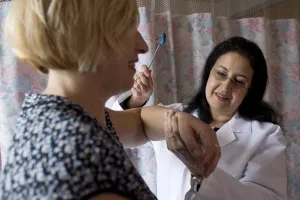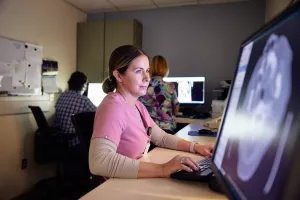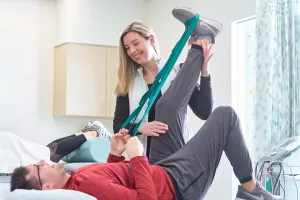Spasticity is a condition that leads to muscle stiffness and tightness. It's usually caused by damage to nerve pathways within the brain or spinal cord that control muscle movement.
Loosening spasticity's grip on your life
Spasticity can have a significant impact on your quality of life. Little things like chatting with a friend or going for a morning walk all of a sudden feel like a big deal when they're difficult or impossible to do.
While there isn't a cure for spasticity, we'll examine your muscle stiffness from all angles to create a treatment plan that puts your comfort first.

Conditions
If you have one or a combination of those conditions and are experiencing any of the following signs and symptoms, you may be dealing with spasticity or a movement disorder:
- Abnormal posture
- Bone and joint deformities
- Contractures (permanent shortening of muscles and tendons)
- Difficulty speaking, eating, drinking and walking
- Involuntary crossing of the legs
- Muscle spasms
- Muscle stiffness or heaviness
- Unusual increase in muscle tone
Some examples of neurological and spinal conditions that can cause spasticity include:
Testing
Testing for spasticity typically involves imaging tests like a CT scan and a physical exam. A CT scan allows your doctor to visually examine your nervous system and identify anything unusual that points to spasticity.
These exam results will help your doctor better understand your condition, including your muscle strength, reflexes and the severity of your condition.
Treatments
Our goal is to help you regain strength, flexibility and everyday self-care skills. To achieve this, we use a combination of treatment methods, including:
- Injections and medications
- Occupational therapy
- Physical therapy
- Speech-language therapy
- Surgery
Medications + injections
Injection therapy is a common and effective way to treat spasticity. These injections reduce pain and make it easier for you to stretch and move around:
- Botox® injection therapy
- Phenol nerve-block injection therapy
- Intrathecal baclofen (ITB) pump placement and therapy
Talk with your doctor to learn if these medications will help control your spasticity symptoms, like muscle spasms and stiffness:
- Baclofen
- Diazepam
- Tizanidine
Therapies
Depending on your condition, we may also recommend one or more of the following non-surgical spasticity treatments:
- Bracing and splinting to help control muscle spasms
- Occupational therapy that improves your ability to perform simple, everyday tasks
- Physical therapy that features exercises and stretches to alleviate your symptoms
- Therapeutic heat, cold and electrical stimulation
Spasticity may also take its toll on the facial, jaw, throat and tongue muscles that help people talk and communicate. That's where speech-language therapy can help you rediscover your voice.
Surgery
Spasticity surgeries usually address tendon issues by either trimming and repairing them (known as a tenotomy) or lengthening them. If your care team determines surgery is your best treatment option, we'll connect you with our teammates in orthopedics or vascular surgery teammates.

From regular office visits to inpatient stays, find the healthcare you need and deserve close to home.

Meet the doctors and care team devoted to supporting you every step of the way along your path to better health.